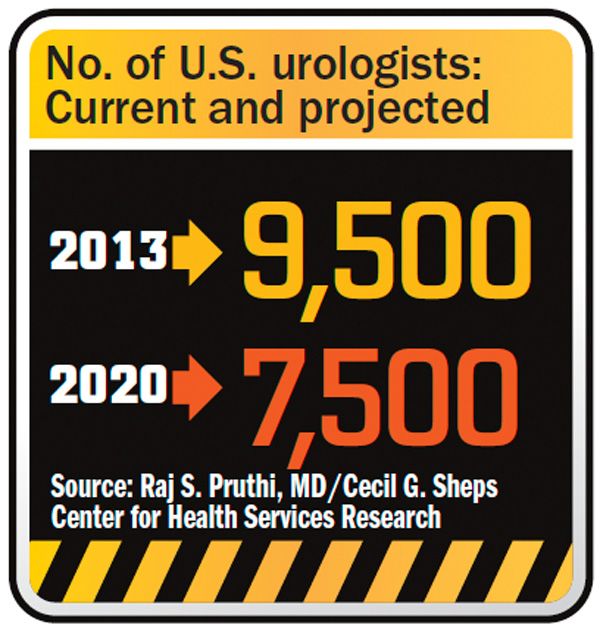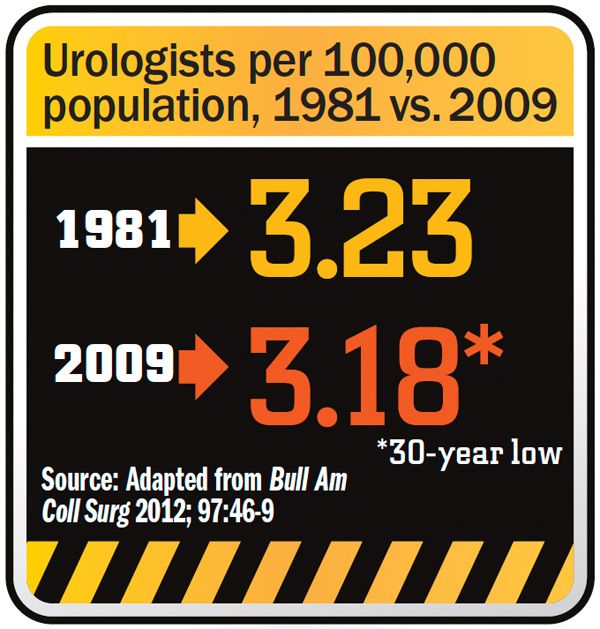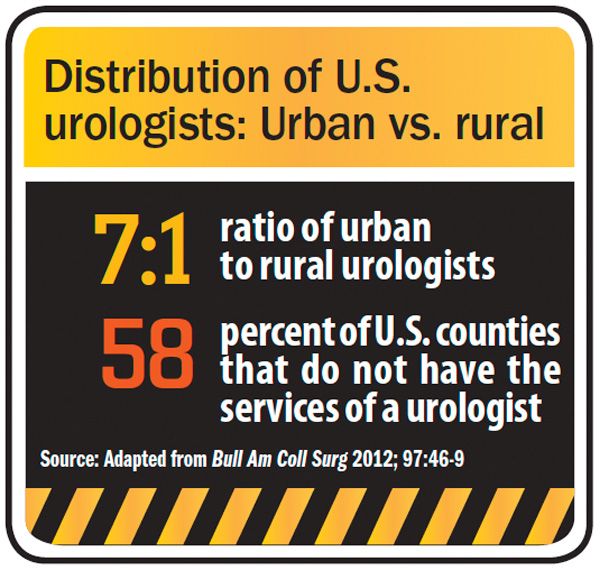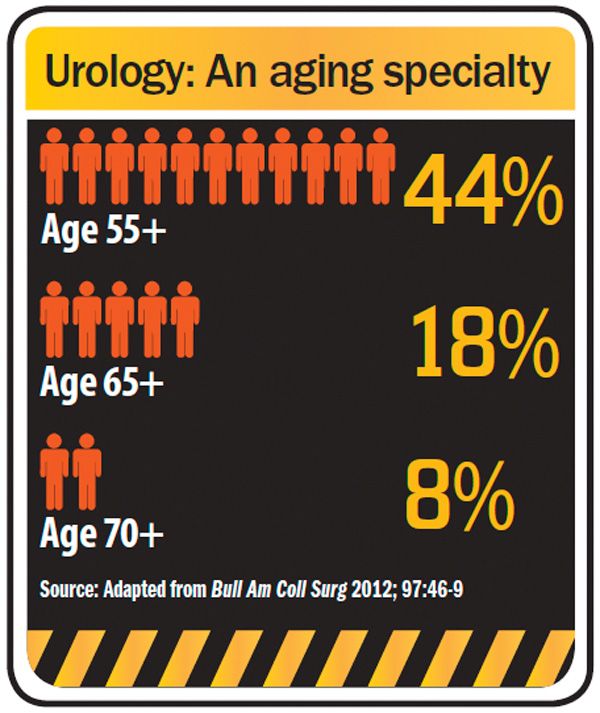Article
Urology work force shortage puts specialty on ‘critical’ list
In this interview, Christopher M. Gonzalez, MD, MBA, discusses the scope of the urology work force problem, the impact of graduate medical education funding caps, and possible long- and short-term solutions.
The number of U.S. practicing urologists has been steadily declining and is now at a 30-year low. In this interview, Christopher M. Gonzalez, MD, MBA, discusses the scope of the problem, the impact of graduate medical education funding caps, and possible long- and short-term solutions. Dr. Gonzalez is professor of urology at the Northwestern Feinberg School of Medicine, Chicago and vice chairman of AUA Health Policy. He was interviewed by Urology Times Editorial Consultant Stephen Y. Nakada, MD, professor and chairman of urology at the University of Wisconsin, Madison.
There has been growing concern about a shortage of U.S. urologists. Can you please define the problem as you see it and the role graduate medical education (GME) funding plays?

In the work force of urology in the United States, we have a significant problem that we’re learning more about as we receive more information. There’s been a 10% decline of urologists per capita over the past 20 years, and as of 2009, we are at a 30-year low at just over three urologists per 100,000 individuals in the U.S.
From the training center perspective, we are also seeing that it is becoming increasingly more difficult to fund GME spots. As you know, in 1997, there was a freeze on GME funding, when there were 170 residency slots per year for urology. Currently, we are training 278 slots per year, which means that over 100 residency slots are not funded by GME. These residency positions are funded from different sources, including clinical revenue and hospital funds, which are no longer sustainable.
What message should we be sending about the importance of GME?
In order to sustain the high quality of care we deliver for U.S. citizens, we need to increase GME funding to continue to train our existing residents and supplement the projected need for more urologists over the next 20 years. As I mentioned, GME funding was frozen 16 years ago, and not only are we not training enough urologists, but now we need to increase the number of urologists that we’re training for both rural and urban areas. By 2030, the U.S. population is predicted to be around 360 million and it is estimated that nearly 20% of the population at that time will be 65 years or older. Elderly patients require as much as threefold the rate of surgical services that the general population consumes, which will strain the work force at that time significantly.
If you look at the big picture, we think there will be a shortage of roughly 130,000 physicians by 2030, with half of the shortage coming from specialty medicine and the other half primary care. Organized medicine, including the AUA, has sent this message to Capitol Hill multiple times, and now we have two viable bills recently introduced, both with the goal of increasing the total number of residency positions by about 15,000 over the next 5 years. Approximately half of the proposed residency position increases in these pieces of legislation are earmarked for primary care and the other half for specialty medicine.
We feel this is a significant step in the right direction; however, it most likely will still not be enough to correct the impending work force shortage in urology. Among specialties, urology was reported to have one of the most profound work force shortages, and was listed as “critical,” according to a 2011 Massachusetts Medical Society study of 18 different physician specialties.
Why is the work force shortage particularly problematic in urology?
In 2009, there were only 3.18 urologists per 100,000 population, which marked a 30-year low in the labor force. The reason for this, I believe, is multifactorial. The average age of a urologist is 52.5 years, with 44% over the age of 55 and more than 18% of urologists age 65 or older, making our specialty the second oldest after thoracic surgery. This contracting urology work force is associated with an aging U.S. population that will require more health care services.

As noted, by 2030 it is estimated that nearly 20% of the population will be 65 years or older. To meet the demands for these population estimates, the Department of Health and Human Services projects a need of 14,000 urologists by 2015 and 16,000 urologists by 2020. It is also important to note that over 30 million new patients will enter into the health care system in 2014 as part of the Affordable Care Act, which promises to magnify the urology work force shortage further.
Can you define the current scope of recruitment trends in urology practice and how it differs in urban and rural environments?
If you look at the number of urologists in the United States, there is about a 7:1 ratio of urban to rural urologists. About 20% of the U.S. population, or more than 50 million people, live in rural areas. We know that 58% of counties in the United States-about 1,800 counties total-currently do not have the services of a urologist; they have zero urologists. This is according to a 2012 report in the Bulletin of the American College of Surgeons. We also know that the mortality from prostate, kidney, and bladder cancer is higher in those counties with no urologists.
The government is looking at addressing this problem from a primary care perspective. We are trying to get them to also look at it from the specialty care perspective. There is momentum to introduce legislation for loan forgiveness and payment incentives for primary care physicians willing to work in rural areas. However, the effects of these incentives may take years to implement, and there is no plan to offer these same incentives for specialty medicine at this time. We currently are not providing the best urologic care we can for a very large segment of the U.S. population due to a work force shortage, and we are trying to inform lawmakers of this significant problem.

Do you think the shortage is a problem of not having enough urologists or a problem with the distribution of urologists?
I think it’s both. The total number of urologists needs to increase to meet many of these demands, but it’s also a distribution issue. In addition to the 7:1 ratio of urban to rural urologists, we’re also seeing that urologists in the urban areas are a little younger-by about 2 years on average-and they tend to belong to bigger groups. The profile of the urologist in rural areas in 2013 is a physician who is a little bit older and is either in solo practice or perhaps with one or two partners, not in a large urology group. The real concern for us is the fact that many rural urologists are near retirement, which may accelerate this work force issue in the next 3 to 5 years, especially if some retire early due the current health care environment.
As organized urology, we need to be more proactive with our distribution strategies and propose incentives for urologists to serve in rural America.
How does a practicing urologist cope with this problem of a work force shortage? What coping strategies are available?
One of the strategies that is being discussed and implemented is the use of physician extenders. We know that in primary care especially, and perhaps in some specialties, physician extenders can do a fairly large percentage of what physicians are currently doing. In urology, we think physician extenders can do approximately one-third of what a urologist can do, so some would argue that bringing in more physician extenders solves the work force problem.
However, we don’t see it that way; as urologists, we still need to do roughly 65% to 70% of our trade due to the complex expertise we have been trained to provide. Physician extenders may help with the initial access issues of seeing a health care professional for a urologic problem, but the majority of urologic care still needs to be provided by a urologist. We don’t feel that introduction of physician extenders will completely solve the overall urologic work force shortage but may be one of the many solutions needed to completely address this issue.
We are totally in agreement with the fact that there is a physician shortage in primary care, but we also feel that, since one out of five visits to a physician are urologic in nature, the more primary care doctors brought in, the more work we’re going to have to do. Remember that 30 million new people will be entering the health care system under the Affordable Care Act, and 20% of the population will be over the age of 65 by 2030. We know that people over age 65 require three times the amount of surgical services that people under that age require. If we look at the association of higher urologic cancer-related mortality in areas with decreased numbers of urologists in rural areas, we know there is going to be a significant burden of urologic disease in the next 10 to 20 years that we are not prepared to meet.

Do you see telemedicine playing a role in addressing this problem?
I think telemedicine is a very interesting area, and this may help with addressing some of the work force issues, especially in rural America. But again, as with physician extenders, telemedicine may cover only a certain percentage of what needs to be done up front to improve access. I feel it will not serve as a substitute for the majority of the diagnostic and treatment-related expertise we provide our patients. Overall, telemedicine may have a role in increasing our efficiency to address access issues, but I don’t see this technology as being the complete answer.
The concept of disruptive technology and innovation is also going to play a role in improving efficiency in the ambulatory and inpatient setting in the near future. Examples include retail clinics, social media, and software that enables home wellness screening and diagnostics that can be quickly transmitted to a physician.The exact role this technology will play in urology remains undetermined, yet there are potential benefits.
There are also other things that we need to consider, including the way we train urologists currently. We may need to think about the time that we take to train residents and how we train them. Perhaps we shorten the time it takes to train a urology resident. This may be possible with the advent of surgical simulators and proficiency labs. Unfortunately, when GME funding was frozen in 1997, robotics and many of the minimally invasive procedures we perform were not around. These teaching methods are extremely expensive and are not covered by GME funds. This is another burden on training programs that is not sustainable and another source of need for GME funding that we are requesting from lawmakers.
Certainly urologists are unique in that they have brisk practices both in the operating room and in the clinic. Can you comment on how that balance will be shifting with the new work force shortage?
I think it’s going to take its toll both in the clinic and certainly in the operating room. In the office, we need to look at things such as navigation systems that escort patients through some of the diagnostic testing and treatment prescribed in the ambulatory setting, and we need to become more efficient through the use of novel management concepts in the office.
One of the biggest issues is patient access, and that’s where most of our patients’ concerns lie. Congress also understands preservation of timely patient access as a primary issue through previous MedPAC reports that outline this issue. The concern about reduced access to physicians in the Medicare program is what led to many of the studies and reports on an impending physician work force shortage in the first place.
So I think if we can improve our efficiency on the front end with physician extenders and technology, this may be a partial solution to help with the access problem. However, to continue to provide the best care we can, we need to continue to train more urologists and properly distribute them to meet the projected population demands.
Do you see an impact of the EHR mandate on access to care? Is it compounding the problem?
The EHR mandate is an unfunded one, which will cost practices time and resources to implement. Implementing an EHR appears to have a temporary negative effect on patient access, yet this is not sustained as physicians become more familiar with the system. Nationally there is momentum by lawmakers to replace fee for service with value-based reimbursement, and implementation of an EHR will be necessary to participate effectively.
As you know, more and more women are now part of the urology work force. How does that play a role?
Women are becoming an increasingly larger portion of our work force. Dr. Raj Pruthi from the University of North Carolina is doing some really good work on this subject. He has taken a look at all of the new urologists joining the work force to determine what the decline in head count as compared to the decline in full-time equivalents (FTE) will be. Some of Dr. Pruthi's preliminary work seems to indicate that there may be more of a decline in FTE for recent and future urologists, meaning that even though the head count may reach a certain point, these individuals may only work a fraction of an FTE, which impacts upon the work force.
This is something that needs to be studied carefully with respect to the new trainees coming into urology. We assume they are going to be a full FTE, but we really don’t know if that is the case. These trends need to be fully understood over the next 5 to 10 years so we can best estimate the appropriate work force.
What’s your best guess right now?
I don’t have enough information to answer that, but I certainly think that the head count and FTE issue is not going to be parallel. We may train more urologists in the future, yet not account for the fact that a number of them may be a partial FTE, which will factor into our overall work force strength.
What about the specific medical aspects of urology; could this eventually go to other providers?
That’s something we certainly want to keep a very close eye on. Obviously we think we provide the best urologic care for any problem involving the genitourinary system, but there are forces that will try to do things similar to what urologists do. We want to make sure that we keep control of these particular disease processes and the way we will do that rests on the high quality of care and education we continue to provide.
What are the key metrics to follow in the future so that this problem can be resolved?
The Department of Health and Human Services estimates that we need 14,000 to 16,000 urologists by 2020. That accounts for the aging population and the number of new people coming into the health care system because of the Affordable Care Act. Even if we increased the number of urology training positions by 5% or 10% with GME funding, we are still going to fall significantly short by 2030 based on these estimates. We now have roughly 9,500 urologists in United States. Even if we increase this number by 15% over each of the next several years, we are still projected to fall short of what is needed, with an estimated 7,500 urologists by 2030. Dr. Pruthi’s group has generated these estimates based on the aging population of urologists nearing retirement, the overall increase in population, and the increase in the number of elderly patients by 2030 (see, “AUA paper: Number of urologists to decline 29% by 2025").
How can urologists focus attention to their community leaders on this issue, and what is organized urology doing to address it?
The AUA and AACU have designated the work force shortage as a legislative priority. Participation of urologists at the Joint Advocacy Conference every year is essential so they can learn more about this and other issues and meet with their elected officials in Washington to discuss and advocate for increased GME funding. Contact with elected officials in one’s home district to discuss the work force shortage and its effect on patient access, especially in rural areas, is also very effective.
In a broad sense, what do you think the solution is to this problem?
The solution is going to be multifactorial.
First, I think we need to train a larger number of urologists, and distribute them more effectively. Most, including the Department of Health and Human Services, generally think this is true. The big question is, how many? We saw this happen back in the 1980s, when there was some debate in the urology community about whether we were training too many urologists or not training enough. Then we had the perfect storm in 1997 when we thought we were training too many urologists, and the number of trainees was cut back to 170 a year. Of course, that was the same year when the GME cap was instituted. Now we’re training roughly 278 urologists a year, so that leaves 108 positions that are not funded by GME.
Some cost estimates, including one published in the Annals of Surgery in 2009, have been done on this as well, which have found that it might take as much as $3 billion to train the necessary number of urologists by 2030.
Second, we have to become more efficient, and we have to be smarter and wiser with the use of physician extenders and technology. Finally, from a training perspective, we need to take a really hard look at how we’re training urologists currently, and whether the amount of training is right and whether we can cut back on the years it takes to complete training. These are tough decisions that we’ll have to consider very soon. UT
















